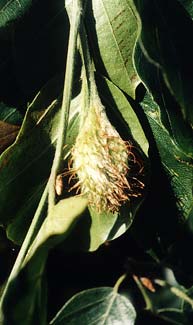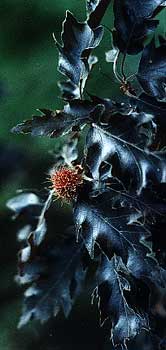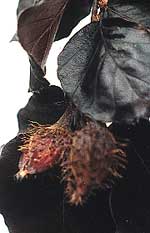
Beechnuts in the Yummy Garden
"Whether in the woodland brown
I heard the beechnut rustle down."
-A. E. Housman
(1859-1936)
(1859-1936)
The first beechnut photo is a furry green bur seen against green leaves. It was taken early in June, & is the fruit of the European weeping green beech (Fagus sylvatica 'Pendula').
The second photo taken around the same time is a beechnut from a Purple Oakleaf Beech (F. sylvatica 'Rohanii') the purple oakleaf Rohani beech. Though the color of the leaves was almost black that week, this soon faded to a bronzy or almost chocolaty purple. On the Rohani, after the burs open & toss their contents, the opened husks cling to the branches like furry brown stars until spring, providing winter decorativeness.
The third photo shows beechnuts at the beginning of the second week in July. Its the fruit of the Black Swan Beech (F. sylvatica 'Black Swan'). The Black Swan is the most amazing of our beeches, the leaves such a deep-deep purple they really do appear black throughout the summer.
These fruits occasionally occur in consecutive years, but tend to appear every second or third year. I wonder if it's a coincidence these all three produced nut burs for 2002, or if they actually are in sync with one another despite being very different cultivars.
 The small triangular nuts occur one, two, or three inside each bur. The nut meat is perfectly edible, having a sweetish taste. When they are ripe & ready for harvest early in Autumn, they begin to fall off the trees. If you have squirrels or even racoons, you may find the beechnuts gone before you can get them, but they won't take them until they are perfect & ripe, so if you're on top of the situation, you'll get most of them yourself.
The small triangular nuts occur one, two, or three inside each bur. The nut meat is perfectly edible, having a sweetish taste. When they are ripe & ready for harvest early in Autumn, they begin to fall off the trees. If you have squirrels or even racoons, you may find the beechnuts gone before you can get them, but they won't take them until they are perfect & ripe, so if you're on top of the situation, you'll get most of them yourself.Cultivated varieties do not have the largest or most numerous beechnuts for harvesting purposes. If you really want a lot of them, you should go for a wild American beech (F. grandifolia). And if you live in a part of the country where the forests are full of beeches, maybe you can beat the bears to a really signficiant harvest. But in an ornamental garden, fancy cultivars can provide an incidental harvest sufficient to work into a couple interesting meals at least.
As a commercial food crop beechnuts are nowadays mainly processed to extract the oil, which is then used as a flavoring for chewing gum. They are also used as livestock feed. The nut can be safely eaten raw, despite that it is very mildly toxic, containing Saponic glycoside, which breaks down when the nut is roasted or otherwise processed. It doesn't taste like much raw, though, so should be roasted.
Roasted then ground, beechnuts can be used as a coffee substitute. Or the roasted nut can be grated as a sprinkle over hot drinks or pies, making a good substitute for fresh-ground nutmeg.
 Roasted beechnuts can also be chopped up with other nuts to make a vegetarian nutburger or nutloaf. My basic nutloaf recipe includes mixed nuts (every kind I can get), bread soaked in milk, grated veggies (carrots, onions, celery & whatever's handy), grated mozorella, herb leaves taken from the garden & chopped fine, & eggs, mixed well & pressed into a loaf pan, top-coated with tomato sauce (& damn it, ketchup really is best), then baked until a straw can be poked into it & come out clean. The same recipe can be used to make nutballs for spaghetti & nutballs.
Roasted beechnuts can also be chopped up with other nuts to make a vegetarian nutburger or nutloaf. My basic nutloaf recipe includes mixed nuts (every kind I can get), bread soaked in milk, grated veggies (carrots, onions, celery & whatever's handy), grated mozorella, herb leaves taken from the garden & chopped fine, & eggs, mixed well & pressed into a loaf pan, top-coated with tomato sauce (& damn it, ketchup really is best), then baked until a straw can be poked into it & come out clean. The same recipe can be used to make nutballs for spaghetti & nutballs.The more gardened nuts you can get from your garden to add to a store-bought array, the better that'll be for your nutloaf recipe. Other garden nuts in additon to beechnuts could include sweet chestnut, chinquapins, black walnut, English walnut, butternuts, filbert hazels, hickory nuts, pine nuts, & acorns. Gardeners further south might well have a few more handy. If you harvest your own sunflower seeds, these mix up well with nuts for any of the above preparation options. Although you'd never catch me shelling those little bastards one by one, I do buy sunflower seeds already shelled to cook with & include them in my nut-mixes for nutloaf.
If you roast such as these together on a cookie sheet in the oven, they can be sprinkled with seasalt or teriyaki sauce for an unusual snack treat. They could also be smoke-roasted in out outdoor barbecue broiler. It'll usually be best to pad them out with store-bought nuts especially if the harvests are small, or else they'll be eaten up too quickly compared to the amount of work getting them out of the husks. And beechnuts do tend to provide tiny harvests of the tiny nuts.